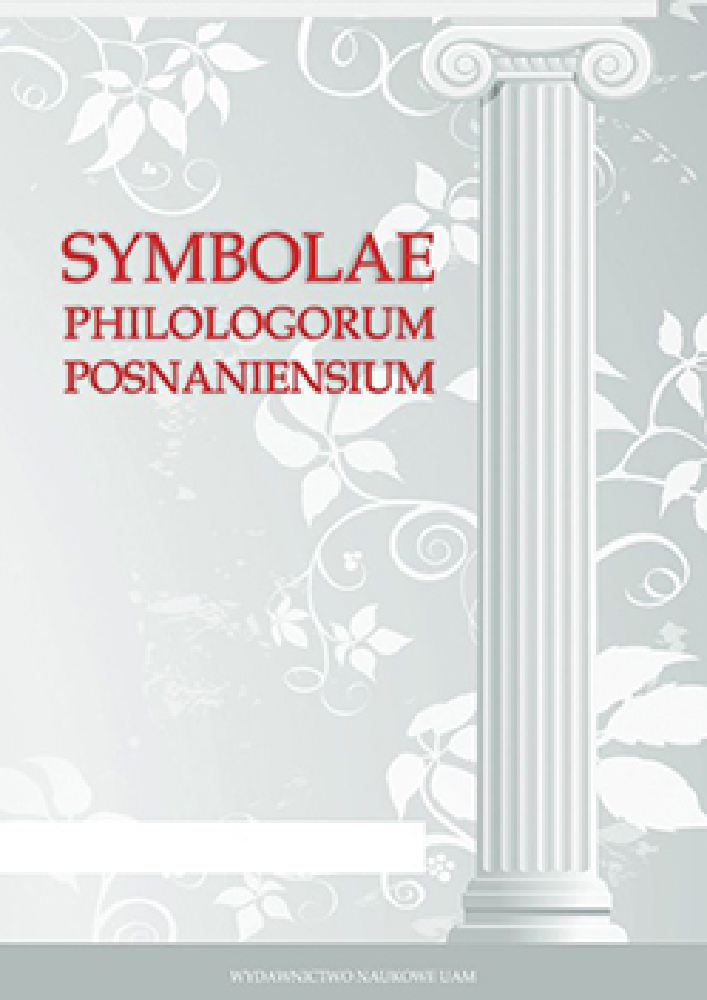Abstrakt
The author of Oedipus Rex manages to reconstruct the hero’s life path against the background of the map of Greece of his day. In doing so he constructs the imaginary of the protagonist’s identity, one that is inextricably linked to his mental blindness as opposed to the tragic, self-inflicted blindness meted out to himself as a punishment for his crimes.
Bibliografia
Primary sources
Sophocles. Oedipus Rex. Ed. R. D. Dawe. 1982. Cambridge.
Chodkowski 2007: Sofokles, Król Edyp. Trans. R. R. Chodkowski. Lublin 2007.
Arystoteles. Poetyka. In Arystoteles, Dzieła wszystkie, Vol. 6. Ed., transl. H. Podbielski. 2001. Warszawa.
Secondary sources
Adkins 1966: Adkins, A. W. H. 1966. “Aristotle and the Best Kind of Tragedy.” Classical Quarterly 16: 78–102.
Berger 2013: Berger, Ł. 2013. “Deixis w scenie wstępnej ‘Edypa’ i jej funkcje.” SPhP XXII/1: 5–18.
Brusewicz 2003: Brusewicz, A. 2003. Trylogia Eurypidesa o Pelopidach i Labdakidach. Toruń.
Catenaccio 2012: Catenaccio, C. 2012 . “Oedipus Tyrannus: The Riddle of the Feet.” The Classical Outlook 89: 102–107.
Cieśluk 2008: Cieśluk, M. 2008. “Zagadki i agon mędrców w ‘Królu Edypie’ Sofoklesa.” Symbolae Philologorum Posnaniensium XVIII: 53–76.
Dodds 1966: Dodds, E. R. 1966. “On Misunderstanding the ‘Oedipus Rex’.” Greece and Rome, 13: 37–49.
Fowler 2008: Fowler, M. A. 2008. The Seer in Ancient Greece. Berkeley, Los Angeles, London.
Głombiowska 1989: Głombiowska, Z. 1989. “Problem prawdy w tragedii Sofoklesa ‘Król Edyp’.” Meander 44, 4–5: 147–154.
Gregory 1995: Gregory, J. 1995 “The Encounter at the Crossroads in Sophocles’ ‘Oedipus Tyrannus’.” The Journal of Hellenic Studies 115: 141–146.
Grelka 2013: Grelka, M. 2013. “On the Question of Knowledge and Blindness in the ‘Oedipus Tyrannus’.” Symbolae Philologorum Posnaniensium XXIII/1: 19–33.
Halliwell 1986: Halliwell, S. 1986. “Where Three Roads Meet: A Neglected Detail in the ‘Oedipus Tyrannus’.” The Journal of Hellenic Studies 106: 187–190.
Hester 1977: Hester, D. A. 1977. “Oedipus and Jonah.” The Cambridge Classical Journal 23: 32–61.
Knox 1966: Knox, B. M. W. 1966. Oedipus at Thebes. Sophocles’ Tragic Hero and His Time. New Haven.
Knox 2007: Knox, B. M. W. 2007. “Introduction to Oedipus the King.” In Bloom’s Modern Critical Interpretations. Update Edition. Ed. H. Bloom: 71–89. New York.
Maślanka-Soro 1991: Maślanka-Soro, M. 1991. Nauka poprzez cierpienie (pathei mathos) u Ajschylosa i Sofoklesa. Kraków.
Papadoupolos 2005: Papadopoulos, Y. 2005. “Potrójny logos mitycznego Sfinksa lub zagadka psychologicznych rozstajów.” Konteksty 591: 51–57.
Parker 1983: Parker, R. 1983. Pollution and Purificaton in Early Greek Religion, Oxford 1983.
Roisman 2003: Roisman, H. M. 2003. “Teiresias, the Seer of ‘Oedipus the King’: Sophocles’ and Seneca’s Versions.” Leeds International Classical Studies 2(5): 1–20.
Rose 2003: Rose, M. L. 2003. The Staff of Oedipus: Transforming Abilities in Ancient Greece. Ann Arbor.
Rybicka 2008: Rybicka, E. 2008. “Od poetyki przestrzeni do polityki miejsca: Zwrot topograficzny w badaniach literackich.” Teksty Drugie: teoria literatury, krytyka, interpretacja 4(112): 21–38.
Souman, Frissen, Sreenivasa, Ernst 2009: Souman, I.L., Frissen, I., Sreenivasa, M.N., Ernst, M.O., 2009. “Walking Straight into Circles (Report).” Current Biology 19: 1538–1542.
Licencja

